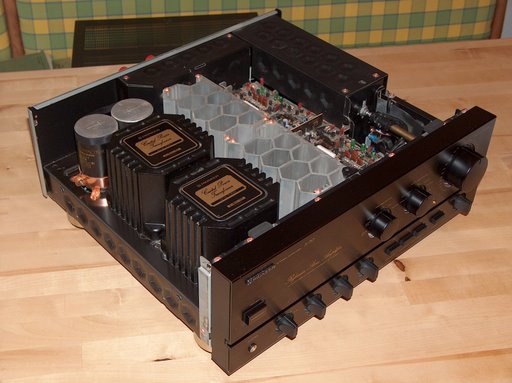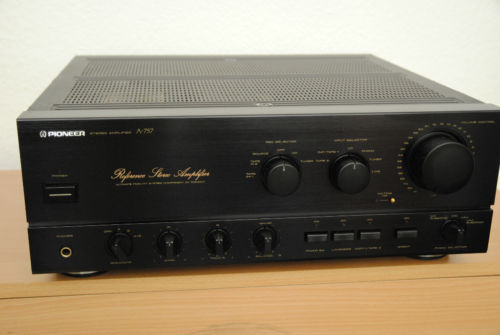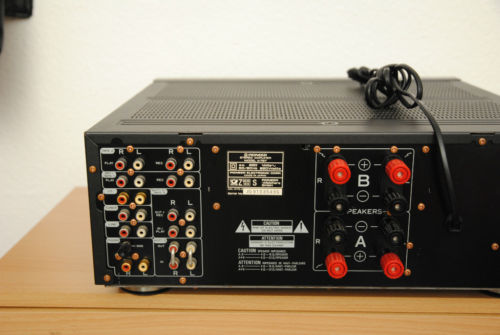Difference between revisions of "Pioneer A-757"
Pfannengyros (talk | contribs) (Angaben und Bild ergänzt) |
|||
| (28 intermediate revisions by 10 users not shown) | |||
| Line 1: | Line 1: | ||
__NOTOC__ | __NOTOC__ | ||
| − | == | + | == Short description == |
| − | {{ | + | Still with copper chassis and horizontal PCB section. The only noticeable difference to the Pioneer A-717 MKII: Smaller knobs now made of aluminium instead of plastic. |
| − | ''' | + | ==Data== |
| − | * | + | {{navigation}} |
| − | * | + | '''General''' |
| − | * | + | * Manufacturer: [[Pioneer]] |
| − | * | + | * Model: A-757 |
| − | * | + | * Type: Integrated amplifier |
| − | * | + | * Years of manufacture: 1989 - 1990 |
| − | * | + | * Made in: Japan |
| − | * | + | * Color: Black |
| − | * | + | * Remote control: No |
| − | * | + | * Power consumption: 820 W (max) |
| − | + | * Dimensions: 420 x 435 x 162 mm (WxDxH) | |
| + | * Weight: 19,5 kg | ||
| + | * Original price approx.: 1'000 DM | ||
| − | ''' | + | '''Connections''' |
| − | * | + | * Number of inputs: 8 |
| − | ** DAT /TAPE 1, TAPE 2, | + | ** DAT /TAPE 1, TAPE 2, ADAPTER1/ TAPE3, ADAPTER 2, CD (gold plated), TUNER, LINE, PHONO (gold plated) |
| − | * | + | * Number of outputs: 2 |
** TAPE 1/CD-R/MD, TAPE 2 MONITOR | ** TAPE 1/CD-R/MD, TAPE 2 MONITOR | ||
| − | ''' | + | '''Specifications''' |
| − | * | + | * Continuous power (at distortion) |
| − | ** 8 Ohm: 2x 95 W | + | ** 8 Ohm: 2x 95 W / 0,003% |
| − | ** | + | ** 4 Ohm: 2x 140 W |
| − | + | 2 Ohm: 2x 200 W | |
| − | ** | + | * Dynamic power |
| − | * | + | ** 8 Ohm: 2x 150 W |
| − | * | + | ** 4 Ohm: 2x 200 W |
| − | ** | + | ** 2 Ohm: 2x 300 W |
| − | * | + | * Total harmonic distortion: 0.003% (20Hz - 20 kHz, 95W, 8 Ohm) |
| − | * | + | * Frequency response: 5 Hz - 70 kHz |
| − | * | + | * Stereo channel separation: |
| − | * | + | * Signal-to-noise ratio: 108 dB |
| − | * | + | * Attenuation factor: 200 |
| − | * | + | * Tone control: analog |
** Bass: ±8 dB (100 Hz) | ** Bass: ±8 dB (100 Hz) | ||
| − | ** | + | ** Treble: ±8 dB (10 kHz) |
| − | * Loudness: | + | * Loudness: yes, button |
| − | * Subsonic: | + | * Subsonic: yes, button |
| − | * Mute: | + | * Mute: yes |
| − | * Direct/Line-Straight: | + | * Direct/Line-Straight: yes |
| − | ''' | + | '''Special Features''' |
| − | * | + | * Record selector switch |
| − | * | + | * Speaker pairs and headphones are switched via relays |
| − | * | + | * Metal front panel |
| − | * Direct - | + | * Direct - switch to bypass the tone control stage |
| − | * Phono - | + | * Phono - input with choice of MM/MM subsonic filter/MC/MC subsonic filter |
| − | * | + | * switchable phono preamplifier |
| + | * Separable pre- and power amplifier | ||
| + | * connections for 2 speaker pairs A+B | ||
| + | * shortened signal paths for the cleanest sound imaginable | ||
| + | * spatially separated stages: Reduced interference | ||
| + | * resonance-damping design: honeycomb-reinforced frame, heat sink and dampers to eliminate microphonic effects | ||
| + | * powerful, low-impedance power supply: 2 power transformers and finned solid cast enclosure ensure high capacitance | ||
| + | * good resonance damping and clean magnetic shielding | ||
| + | * "Non-Switching" Type III: elimination of switching distortion and improved stability at low impedances | ||
| + | * phono equalizer (can be switched off) with high gain; suitable for MM and MC systems | ||
| − | == | + | ==Notes== |
| − | + | * Previous model: | |
| − | * | + | * [[Pioneer A-717 MK II]] |
| − | * Pioneer A- | ||
| − | |||
| − | |||
| − | Pioneer | + | * Successor model: |
| + | * [[Pioneer A-757 MK II]] | ||
| − | |||
| − | + | * Other models in the same series: | |
| + | *[[Pioneer A-225]] | ||
| + | *[[Pioneer A-335]] | ||
| + | *[[Pioneer A-445]] | ||
| + | *[[Pioneer A-656]] | ||
| + | *[[Pioneer A-757]] | ||
| + | *[[Pioneer A-858]] | ||
| − | |||
| + | == Pictures == | ||
| + | *[[Image: Pioneer A-757 | ||
| + | [[Image:HPIM0855kl.JPG|Interior view]] | ||
| − | |||
| − | |||
| − | == | + | * Image: Pioneer A-757 |
| + | [[File:Pioneer A-757.jpg]] | ||
| + | |||
| + | |||
| + | * Image: Pioneer A-757 | ||
| + | [[File:Pioneer A-757 back.jpg]] | ||
| + | |||
| + | |||
| + | == Reviews == | ||
| + | * Pioneer had at that time, based on the A-717, a whole series of amplifiers of the same basic concept: Massive construction with oversized components throughout, which was reflected in the weight. The durability is enormous, so that most amplifiers still available used today work absolutely flawlessly. Especially the typical scratching of old switches and pots is rather rare. From 7x7 the amplifiers have two transformers in the power supply. However, these do not serve as usual for the separate supply of the two stereo channels, but provide the positive and the negative operating voltage of the power amplifiers. | ||
| + | |||
| + | * Although the amplifiers have two pairs of connections on the rear panel, each connected by a wire jumper, they do not have pre and power stages that can be separated. Rather, this so-called adapter connection is located before the volume control and tone control stage. Therefore, although the Pioneer amplifiers can be used as power amplifiers for other preamplifiers, it is not possible to connect the Pioneer preamplifiers to other power amplifiers. | ||
| + | |||
| + | * The sound of these amplifiers can be described as warm, powerful and precise compared to similar amplifiers from other manufacturers, although perhaps the last bit of precision is missing compared to several times more expensive devices. The devices have an excellent price-performance ratio, especially the used ones, which are technically in new condition. | ||
| + | |||
| + | The amplifiers of the A-656 to A-757 series, possibly also later models, have only one real weak point: a capacitor in the protection and switch-on delay circuit is broken, whereupon the loudspeaker relays switch on delayed and then buzz for a while. The repair should cost about 50 € in a specialist shop, plus 80 cents material costs. | ||
| + | |||
== Links == | == Links == | ||
| − | [[ | + | |
| + | [[Category:Integrated amplifier]] | ||
Latest revision as of 23:46, 7 April 2021
Short description
Still with copper chassis and horizontal PCB section. The only noticeable difference to the Pioneer A-717 MKII: Smaller knobs now made of aluminium instead of plastic.
Data
General
- Manufacturer: Pioneer
- Model: A-757
- Type: Integrated amplifier
- Years of manufacture: 1989 - 1990
- Made in: Japan
- Color: Black
- Remote control: No
- Power consumption: 820 W (max)
- Dimensions: 420 x 435 x 162 mm (WxDxH)
- Weight: 19,5 kg
- Original price approx.: 1'000 DM
Connections
- Number of inputs: 8
- DAT /TAPE 1, TAPE 2, ADAPTER1/ TAPE3, ADAPTER 2, CD (gold plated), TUNER, LINE, PHONO (gold plated)
- Number of outputs: 2
- TAPE 1/CD-R/MD, TAPE 2 MONITOR
Specifications
- Continuous power (at distortion)
- 8 Ohm: 2x 95 W / 0,003%
- 4 Ohm: 2x 140 W
2 Ohm: 2x 200 W
- Dynamic power
- 8 Ohm: 2x 150 W
- 4 Ohm: 2x 200 W
- 2 Ohm: 2x 300 W
- Total harmonic distortion: 0.003% (20Hz - 20 kHz, 95W, 8 Ohm)
- Frequency response: 5 Hz - 70 kHz
- Stereo channel separation:
- Signal-to-noise ratio: 108 dB
- Attenuation factor: 200
- Tone control: analog
- Bass: ±8 dB (100 Hz)
- Treble: ±8 dB (10 kHz)
- Loudness: yes, button
- Subsonic: yes, button
- Mute: yes
- Direct/Line-Straight: yes
Special Features
- Record selector switch
- Speaker pairs and headphones are switched via relays
- Metal front panel
- Direct - switch to bypass the tone control stage
- Phono - input with choice of MM/MM subsonic filter/MC/MC subsonic filter
- switchable phono preamplifier
- Separable pre- and power amplifier
- connections for 2 speaker pairs A+B
- shortened signal paths for the cleanest sound imaginable
- spatially separated stages: Reduced interference
- resonance-damping design: honeycomb-reinforced frame, heat sink and dampers to eliminate microphonic effects
- powerful, low-impedance power supply: 2 power transformers and finned solid cast enclosure ensure high capacitance
- good resonance damping and clean magnetic shielding
- "Non-Switching" Type III: elimination of switching distortion and improved stability at low impedances
- phono equalizer (can be switched off) with high gain; suitable for MM and MC systems
Notes
- Previous model:
- Pioneer A-717 MK II
- Successor model:
- Pioneer A-757 MK II
- Other models in the same series:
- Pioneer A-225
- Pioneer A-335
- Pioneer A-445
- Pioneer A-656
- Pioneer A-757
- Pioneer A-858
Pictures
- [[Image: Pioneer A-757
- Image: Pioneer A-757
- Image: Pioneer A-757
Reviews
- Pioneer had at that time, based on the A-717, a whole series of amplifiers of the same basic concept: Massive construction with oversized components throughout, which was reflected in the weight. The durability is enormous, so that most amplifiers still available used today work absolutely flawlessly. Especially the typical scratching of old switches and pots is rather rare. From 7x7 the amplifiers have two transformers in the power supply. However, these do not serve as usual for the separate supply of the two stereo channels, but provide the positive and the negative operating voltage of the power amplifiers.
- Although the amplifiers have two pairs of connections on the rear panel, each connected by a wire jumper, they do not have pre and power stages that can be separated. Rather, this so-called adapter connection is located before the volume control and tone control stage. Therefore, although the Pioneer amplifiers can be used as power amplifiers for other preamplifiers, it is not possible to connect the Pioneer preamplifiers to other power amplifiers.
- The sound of these amplifiers can be described as warm, powerful and precise compared to similar amplifiers from other manufacturers, although perhaps the last bit of precision is missing compared to several times more expensive devices. The devices have an excellent price-performance ratio, especially the used ones, which are technically in new condition.
The amplifiers of the A-656 to A-757 series, possibly also later models, have only one real weak point: a capacitor in the protection and switch-on delay circuit is broken, whereupon the loudspeaker relays switch on delayed and then buzz for a while. The repair should cost about 50 € in a specialist shop, plus 80 cents material costs.


